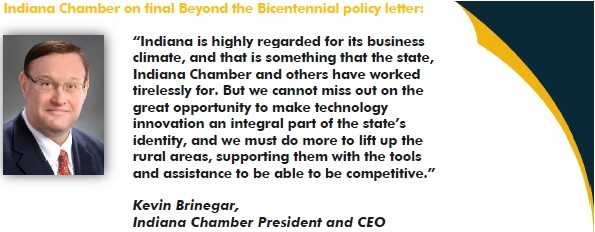 In our fourth and final letter to the major party gubernatorial candidates, the Indiana Chamber calls for additional investment in innovation and entrepreneurs, and addressing the economic divide within the state.
In our fourth and final letter to the major party gubernatorial candidates, the Indiana Chamber calls for additional investment in innovation and entrepreneurs, and addressing the economic divide within the state.
The organization’s six-week Beyond the Bicentennial campaign (going beyond the state’s first 200 years) has focused on the “most potentially impactful public policies to ensure Indiana doesn’t become complacent and continues to push for progress in needed areas.” The blueprint for the campaign comes from the Indiana Chamber’s Indiana Vision 2025 plan, introduced in 2012, and the four economic drivers within the plan. Dynamic and Creative Culture is that fourth driver.
Indiana Chamber President and CEO Kevin Brinegar says continuing efforts to enhance Indiana’s business climate will revolve around “quality of place” aspects. That includes changing the inaccurate global perception that Indiana is not a welcoming place by expanding civil rights protections to include sexual orientation and gender identity.
 “We would hope this basic guarantee for Hoosier citizens would be followed by a moratorium on social issues, so we can, collectively, focus on the important economic and job-related challenges that are facing our state,” Brinegar asserts.
“We would hope this basic guarantee for Hoosier citizens would be followed by a moratorium on social issues, so we can, collectively, focus on the important economic and job-related challenges that are facing our state,” Brinegar asserts.
Those challenges include enhancing the environment for entrepreneurial and start-up businesses, as well as supporting rural areas of the state that are struggling to keep up with attracting jobs and employees. An increased focus on the technology sector and more opportunities for venture capital funding are also needed.
“Indiana is highly regarded for our business climate, and that is something that the state, Indiana Chamber and others have worked tirelessly for,” Brinegar continues. “But we cannot miss out on the great opportunity to make technology innovation an integral part of the state’s identity, and we must do more to lift up the rural areas, supporting them with the tools and assistance to be able to be competitive.”
The Indiana Technology & Innovation Council, formed this summer and managed by the Indiana Chamber, will lend a unified voice to that area and push for policies at the Statehouse. Those policies, notes Brinegar, are to be announced at a mid-December event.
The previous letters of the Beyond the Bicentennial campaign focus on the Indiana Vision 2025 drivers. Each one of those areas also impacts the state’s ability to possess a Dynamic and Creative Culture.
The first letter, on Outstanding Talent, highlighted the need for expansion of the pre-kindergarten pilot program and additional resources for job training. The second letter, on Attractive Business Climate, called for an increase in the cigarette tax and increasing the legal smoking age to 21; additionally, continued emphasis on removing the burdensome business personal property tax was noted. The third letter, on Superior Infrastructure, called for common sense measures to provide sustainable long-term road funding, diversify Indiana’s energy mix and put a statewide water resources plan into place.
All four installments are online at www.indianachamber.com/letters.

 Charlie Cook is editor and publisher of the
Charlie Cook is editor and publisher of the  Richard Mourdock (R) and Joe Donnelly (D) are in a statistical dead heat for the open U.S. Senate seat, with 17% of voters in that race still undecided, according to a new statewide poll released today by the Indiana Chamber of Commerce.
Richard Mourdock (R) and Joe Donnelly (D) are in a statistical dead heat for the open U.S. Senate seat, with 17% of voters in that race still undecided, according to a new statewide poll released today by the Indiana Chamber of Commerce.